North Carolina is home to around 20 total species of turtles ranging from tiny three-inch mud turtles to massive sea turtles that can reach upwards of 5 feet long! If you’re curious about some of the Tar Heel State’s resident-shelled reptiles, you’re in the right place. Below, we’ll take an in-depth look at 10 of the amazing turtle species you can find in North Carolina.
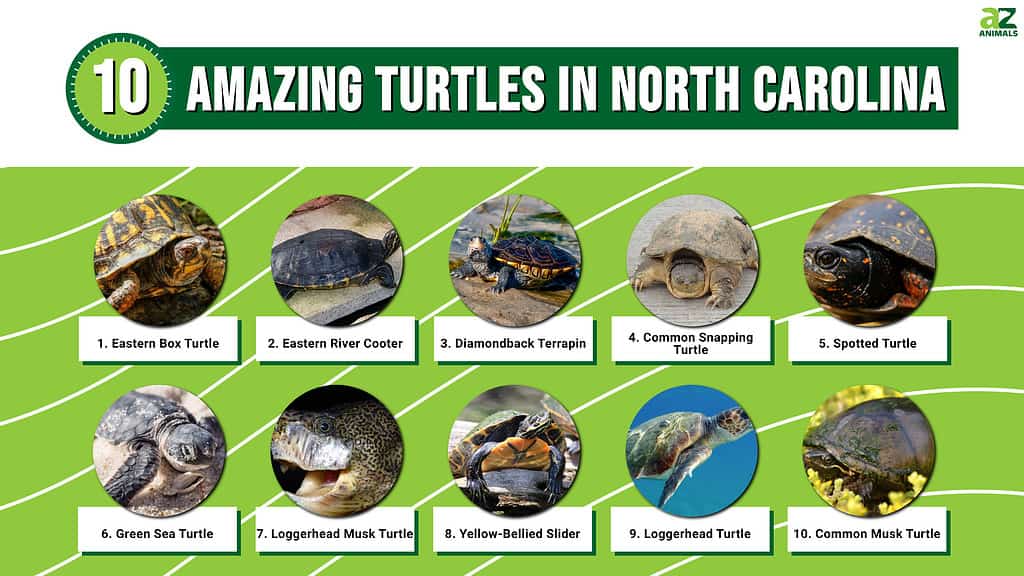
1. Eastern Box Turtle (Terrapene carolina carolina)
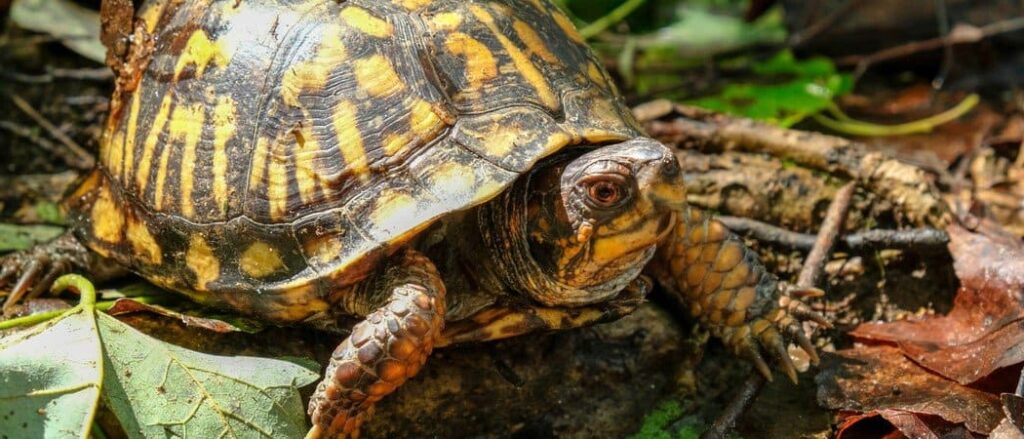
The eastern box turtle is commonly found near small bodies of freshwater.
©samray/Shutterstock.com
The eastern box turtle is actually one of the common box turtle’s three living subspecies. It is perhaps best known for its double-hinged plastron (the part of the shell covering the turtle’s belly). This allows the turtle to fully pull its head and limbs inside the shell, closing the shell’s hinges and turning it into a protective “box” that allows the turtle to hide from predators.
It ranges from around 4 to 8 inches long and has a tall, high dome-shaped carapace (the top portion of the shell). This carapace ranges wildly in color, but it’s often brown with irregular yellow, orange, or reddish splotches or patterning. Its skin color also varies but is most often brown with similarly yellowish or orange striping and splotches throughout the body.
Interestingly, eastern box turtles are slightly sexually dimorphic. This means males and females differ slightly in appearance. Males usually have red eyes, while female turtles’ eyes are more of a drab brown shade.
The eastern box turtle’s geographic range covers most of the eastern United States. It lives as far north as southern Maine and as far south as northern Florida! It can be found throughout North Carolina, typically in forested areas near small bodies of freshwater despite being a mostly terrestrial species.
2. Eastern River Cooter (Pseudemys concinna concinna)

The eastern river cooter can be found in central and eastern North Carolina.
©NasserHalaweh / CC BY-SA 4.0 – License
The eastern river cooter is one of North Carolina’s larger turtles. It ranges from around 8 to 14 inches long and has a wide, flat, oval-shaped shell with slightly flared edges on the sides of its carapace. The shell is mostly dark greenish brown with a yellow or reddish C-shaped marking facing the turtle’s rear end.
On average, female river cooters are larger and longer than males. On both sexes, the plastron is yellow to orange with a dark pattern outlining the individual scutes. This makes the eastern river cooter easy to identify compared to the other known subspecies, the Suwanee cooter, as it lacks this dark plastron patterning. The turtle’s skin is usually dark green with thin yellow or off-white striping throughout.
The eastern river cooter’s geographic range covers most of America’s lower Midwest region as well as parts of the Southeast. It can be found throughout central and eastern North Carolina. Like most river turtles, it prefers moving bodies of freshwater like rivers and streams with lots of vegetation.
Notably, eastern river cooters are capable of breathing underwater. They use a specialized sac in their tails to essentially breathe through their butts while completely submerged!
3. Diamondback Terrapin (Malaclemys terrapin)
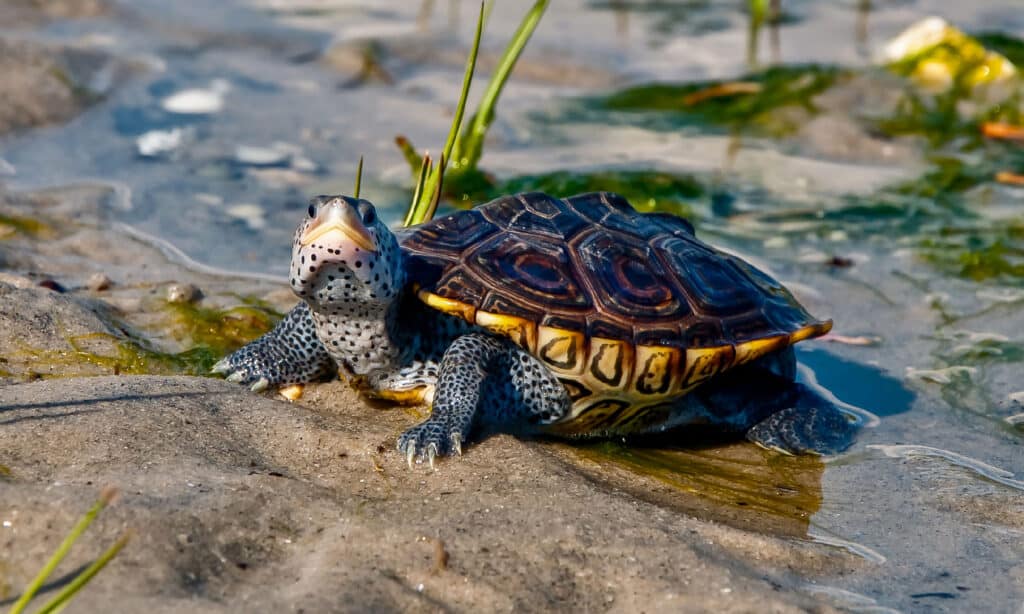
Female diamondback terrapins are larger than males.
©iStock.com/JasonOndreicka
The diamondback terrapin has a striking appearance due to its pale grey skin with dark brown or black markings. Additionally, its carapace is covered with distinct, concentric circle-shaped markings on each individual scute. Its shell ranges in color from brown and grey to orange and yellow and is slightly wider at the back than the front.
At just 4 to 9 inches on average, this little reptile is on the smaller end as far as turtles go. Females are longer and larger on average than males. Both sexes have very large, wide webbed feet for their comparatively small size.
Diamondback terrapins primarily live in both fresh and brackish water along the US eastern coast. They live as far north as Massachusetts and as far south as northern Florida! In North Carolina, this turtle can be found in coastal marshes and swamps along the state’s eastern coast.
4. Common Snapping Turtle (Chelydra serpentina)
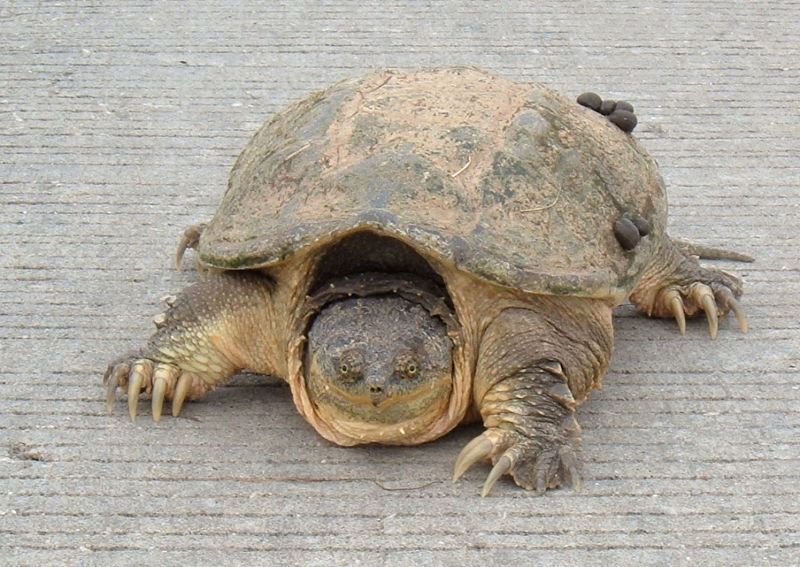
The common
snapping turtle
is one of the world’s largest freshwater turtles.
This massive, prehistoric-looking turtle is easy to identify thanks to its large, wide head, prominent, sharp beak, and surprisingly long neck and limbs. Part of the species’ scientific name, serpentina, comes from the species’ long, serpentine neck. It ranges from 8 to 14 inches and weighs 20 to 50 pounds on average, though some individuals have reached 70+ pounds.
Common snapping turtles can live in just about any body of fresh water (and they can tolerate brackish water, too). They are extremely hardy and highly adaptable. However, they prefer muddy-bottomed lakes and ponds with lots of vegetation. Their geographic range covers much of the American Midwest as well as the eastern half of the country. In North Carolina, these turtles can be found throughout the entire state.
5. Spotted Turtle (Clemmys guttata)

The spotted turtle prefers swamps and marshes.
©iStock.com/JasonOndreicka
True to its name, the spotted turtle’s low, flat carapace is dark brown and covered in tiny yellow (or white) spots! Its skin is similarly dark brown or greyish brown with yellow spots, but the turtle’s underside is much lighter and more yellowish or orange in color. On average, it reaches 3 to 5 inches long.
This semi-aquatic turtle prefers swamps, marshes, ponds, and bogs with lots of vegetation and a soft, muddy bottom for burrowing. Its geographic range covers most of the US eastern coast from southern Maine all the way down to northern Florida. It can also be found in the Great Lakes area. In North Carolina, you can find this turtle in the eastern half of the state, particularly on its eastern coast.
As a sexually dimorphic species, males have longer, thicker tails than females and also have darker-colored eyes and faces.
6. Green Sea Turtle (Chelonia mydas)

Green sea turtles live in subtropical waters worldwide.
©Magdalena Paluchowska/Shutterstock.com
Although most of North Carolina’s sea turtles are loggerheads, the green sea turtle also occasionally nests on the beaches along the state’s eastern coast. It is named not for its body color but for the oddly greenish body fat under its shell. Absolutely huge in size, it can grow up to 5 feet in length and commonly weighs 150 to 450 pounds on average.
Most green sea turtles are actually mostly brown in color. They have off-white or yellowish skin with large brown splotches. Their underside is much lighter than the top portion of the body and carapace. The turtle’s shell changes color over time with age, but it’s usually brown with varying white, yellow, and reddish markings.
Green sea turtles live throughout tropical and subtropical waters worldwide. They nest on North Carolina’s beaches from May through August yearly. They are mostly herbivorous species, mainly feeding on seagrass and the occasional jellyfish.
7. Loggerhead Musk Turtle (Sternotherus minor)
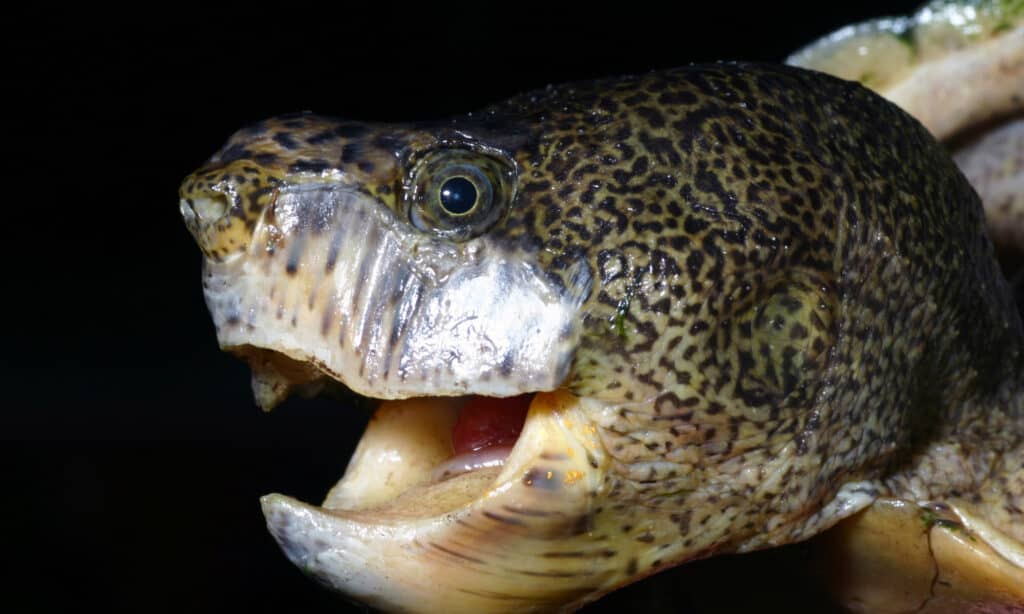
Loggerhead musk turtle is small in size.
©Michael Benard/Shutterstock.com
Not to be confused with the massive loggerhead sea turtle, the loggerhead musk turtle is very small in size at just 3 to 5 inches long. This species is also commonly known as the stripe-necked musk turtle in some regions.
The loggerhead musk turtle has light orange to yellowish skin with a dark brown striped pattern along the head and neck. Its carapace is greenish brown or light brown with small reddish or dark brown markings. Like the loggerhead sea turtle, this species is named for its large, wide head compared to its small body size.
This species’ geographic range covers most of the American Southeast, from northern Florida up to North Carolina and Virginia. It can mainly be found in western North Carolina. Its preferred habitats are clean bodies of freshwater like ponds, lakes, and slow-moving streams.
8. Yellow-Bellied Slider (Trachemys scripta)

Yellow-bellied sliders have a brown or green shell with yellow on their underside.
©iStock.com/jrubacha
The yellow-bellied slider is one of three subspecies of the pond slider turtle, Trachemys scripta. It is closely related to the red-eared slider.
On average, yellow-bellied sliders range from 5 to 13 inches in length. Females are much longer and larger than males. The turtle’s carapace is a greyish dark brown, and it can have yellow stripe markings that typically fade with age. The plastron and underside of the turtle’s body is bright yellow. This bright yellow coloration extends up the turtle’s neck and chin.
This turtle’s geographic range covers most of the American Southeast, from northern Florida up to southern Virginia and as far west as Alabama. It lives throughout eastern North Carolina. As a semi-aquatic species, it usually lives near small freshwater habitats like ponds and streams, spending its days basking on nearby logs and rocks. It has also become popular in the pet trade.
9. Loggerhead Turtle (Caretta caretta)
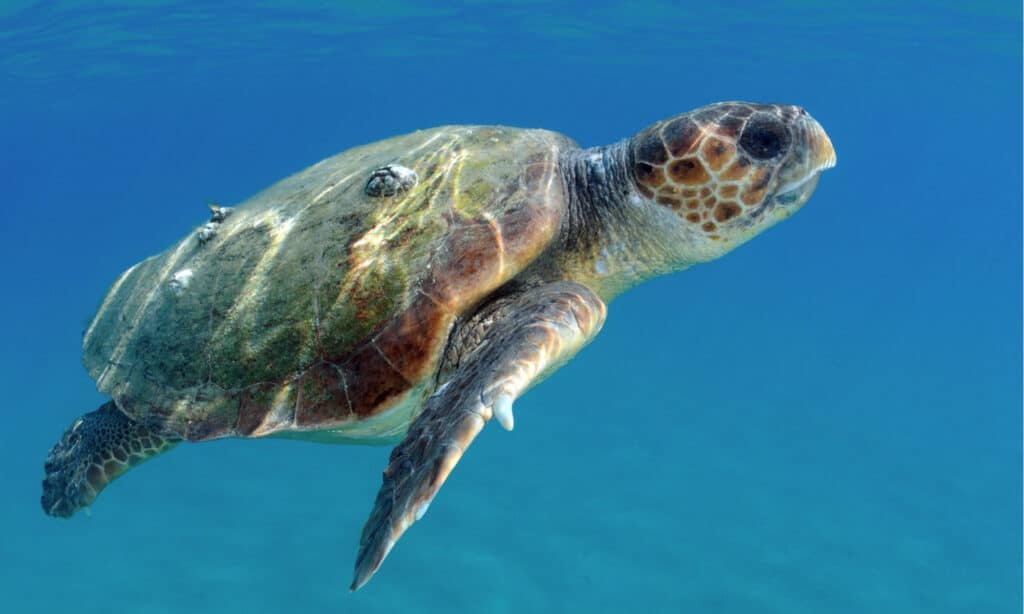
Loggerhead sea turtles can weigh as much as 500 pounds!
©Matteo photos/Shutterstock.com
The loggerhead sea turtle is named for its large, wide head. It has off-white or yellowish skin with reddish-brown splotches. The turtle’s carapace is rugged and textured, usually dark reddish brown in color. The underside, the plastron, is a lighter off-white or pale yellow color. It reaches a whopping 300 to 500 pounds and is 30 to 35 inches long on average!
As a sexually dimorphic species, male loggerhead sea turtles have larger heads, longer tails, and longer claws than females. The species has the widest geographic range of any sea turtle and lives throughout the Atlantic, Pacific, and Indian oceans as well as the Mediterranean Sea. It nests as far north as Virginia and nests on North Carolina’s beaches from May through August each year.
Notably, the loggerhead sea turtle is the most common sea turtle in North Carolina and the largest hard-shelled turtle in the world!
10. Common Musk Turtle (Sternotherus odoratus)

Common musk turtles can release a stinky odor to discourage predators from attacking them.
©Ryan M. Bolton/Shutterstock.com
Also known as the “stinkpot” turtle for its stinky defense mechanism, the common musk turtle can spray a foul-smelling substance from scent glands on the side of its shell. Despite its small size at just 3 to 5 inches long, it doesn’t have as many natural predators as other similar turtle species.
The common musk turtle is easy to identify thanks to its dark brown, almost black skin with thin white or yellowish stripes along the sides of its head and neck. It has a tall, rounded dome-shaped carapace that is dark brown with lighter brown or reddish markings. Interestingly, it has a long neck and short legs for its size. Males have longer spiked tails compared to females.
This little pond turtle’s geographic range covers most of the southern Midwest and the eastern half of the United States. It lives as far north as southern Canada and as far south as northern Florida! Generally, it prefers freshwater habitats like slow-moving or still ponds, streams, and lakes with muddy bottoms and lots of vegetation. It can be found throughout North Carolina.
Summary of 10 Amazing Turtles in North Carolina
| Rank | Amazing Turtle |
|---|---|
| 1 | Eastern Box Turtle |
| 2 | Eastern River Cooter |
| 3 | Diamondback Terrapin |
| 4 | Common Snapping Turtle |
| 5 | Spotted Turtle |
| 6 | Green Sea Turtle |
| 7 | Loggerhead Musk Turtle |
| 8 | Yellow-Bellied Slider |
| 9 | Loggerhead Turtle |
| 10 | Common Musk Turtle |
The photo featured at the top of this post is © Matteo photos/Shutterstock.com
Thank you for reading! Have some feedback for us? Contact the AZ Animals editorial team.






